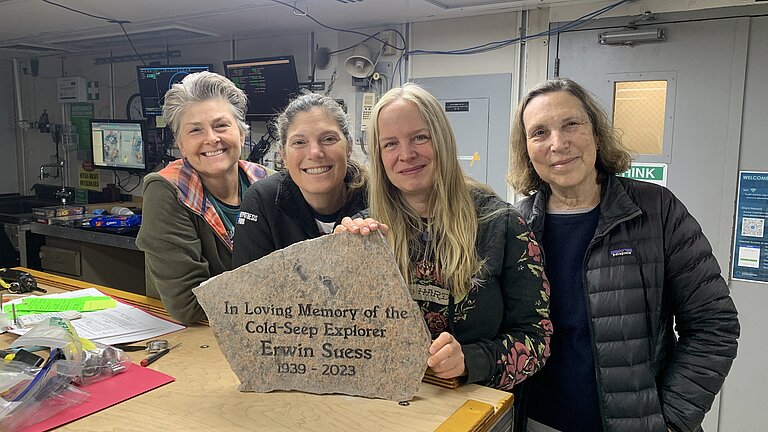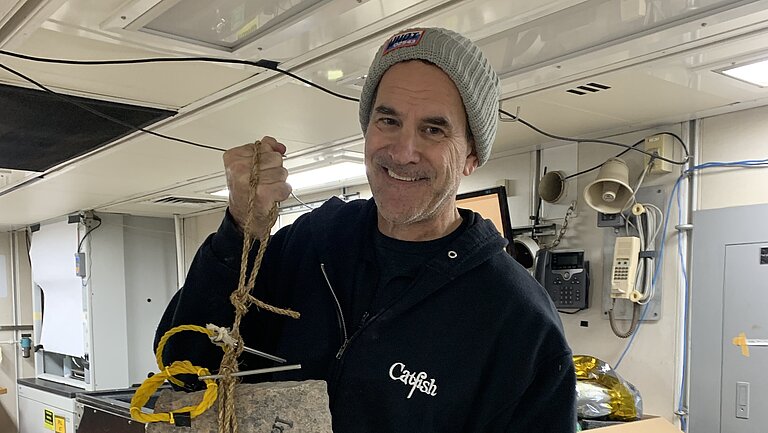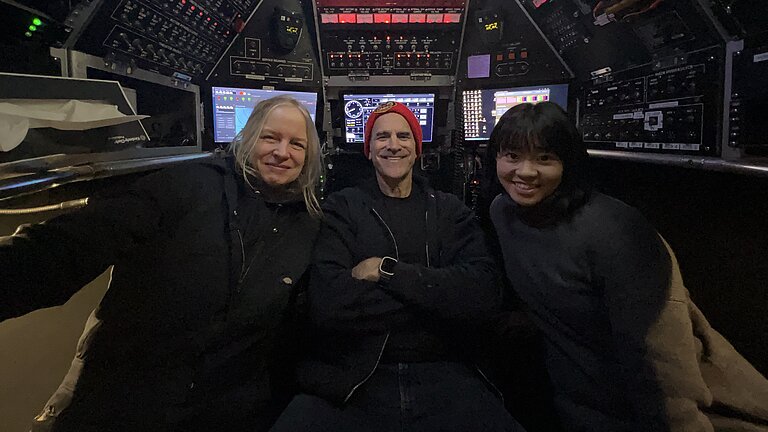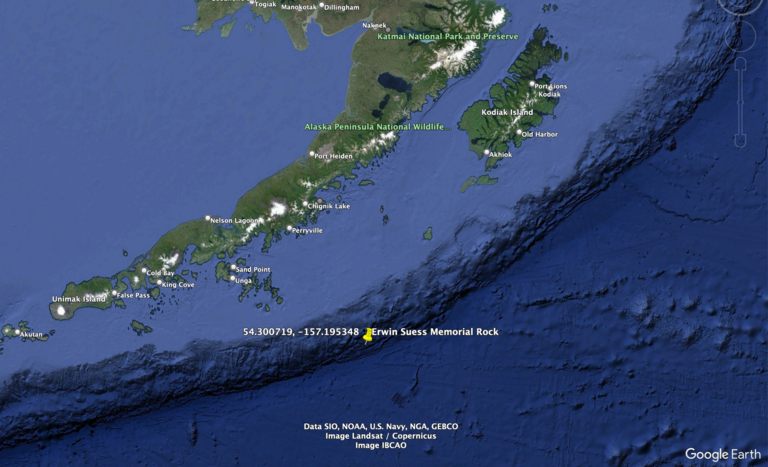Last honour in 4819 metres depth
Memorial rock for Professor Dr. Erwin Suess placed in the Aleutian Trench off Alaska
Dr. Erwin Suess died on 28 September 2023 in Corvallis, Oregon. He had a significant influence on marine geosciences in Germany and the United States of America. In Kiel, he helped to establish the then Centre for Marine Geosciences (GEOMAR) and, as Director, prepared the merger with the Institute of Marine Sciences (IfM), which ultimately led to the founding of IFM-GEOMAR, today's GEOMAR Helmholtz Centre for Ocean Research Kiel.
Now, former companions have placed a memorial rock for Dr. Suess at a depth of 4819 metres in the Aleutian Trench off Alaska. The ceremony happened during a recent expedition with the American research vessel ATLANTIS, which used the submersible ALVIN to investigate methane seeps. Dr. Suess discovered these methane seeps in 1994 during a GEOMAR expedition with the German research vessel SONNE.
The memorial rock was placed by former GEOMAR scientist Dr. Tina Treude, Professor at the University of California, Los Angeles (UCLA), on behalf of the methane seep research community. For Dr. Treude, this moment was historic: "The research on methane sources initiated by Dr. Suess has significantly shaped my own scientific career and that of many other scientists. Even on our current expedition to the Aleutian Trench, 30 years later, we are still using the expedition reports and publications from Dr. Suess' working group as a guide for our research."
Erwin Suess was the first to discover the presence of cold and methane-rich seeps on the sea floor at the active continental margins, which are driven by the submergence of oceanic crust beneath the continents. These cold seeps are the counterpart to hot hydrothermal vents. The cold water and methane gas that emerge from the seeps usually come from great depths beneath the sea floor.
Dr. Klaus Wallmann, Professor of Marine Environmental Geology at GEOMAR, remembers the discovery of these cold seeps in the Aleutian Trench very well: "It was my first sea-going expedition as a young GEOMAR scientist. I found it very exciting to explore these oases with their complex ecosystems in the dark deep sea and to understand how water and natural gas can rise from the deep subsurface to the sea floor." Today, Dr. Wallmann leads the Marine Geosystems research unit founded by Erwin Suess at GEOMAR. He uses the knowledge of cold seeps on the seabed to better understand the extent to which carbon dioxide can be stored under the seabed in the fight against climate change.
The current expedition with the American submersible ALVIN to the Aleutian Trench is investigating the importance of methane seeps for deep-sea communities. Expedition leader Professor Dr. Lisa Levin from the Scripps Institution of Oceanography in San Diego says: "We propose that methane becomes more important as a food source for deep-sea communities with increasing water depth. To test our hypothesis, we are comparing methane seeps at shallow and deep water depths. The discovery of methane seeps in the Aleutian Trench by Dr. Suess is an important basis for our investigations."
This is the first entirely scientific expedition to utilize the extended diving capability of the American submersible ALVIN. Before the submersible was upgraded two years ago, the maximum diving depth was 4500 metres. ALVIN is now approved for diving depths of up to 6500 metres. This extension allowed the American research team led by Dr. Levin to dive for the first time to the methane seeps discovered by Dr. Suess, which are situated at water depths of between 4800 and 5000 metres - and to place the memorial rock during one of their dives.

The four project leaders with the memorial rock for Dr. Erwin Suess: Shana Goffredi (Occidental College), Victoria Orphan (California Institute of Technology), Tina Treude (UCLA) and expedition leader Lisa Levin (Scripps Institution of Oceanography) (from left to right). Photo: Tina Treude, UCLA

ALVIN pilot Bruce Strickrott (WHOI) prepares to deploy the memorial rock with the submersible ALVIN. Photo: Tina Treude, UCLA

The team in the submersible ALVIN shortly after placing the memorial rock: Prof Tina Treude (UCLA), Alvin Pilot Bruce Strickrott (WHOI), and PhD student Kendra Lee (Scripps Institution of Oceanography). Photo: Bruce Strickrott, WHOI

The memorial rock for Dr. Erwin Suess is placed on the seabed by the arm of the submersible ALVIN. Photo: WHOI/Alvin

The memorial rock for Dr. Erwin Suess is received by the deep-sea community of methane springs in the Aleutian Trench at a water depth of 4818 metres. The stone is surrounded by chemosynthetic mussels and worms, which are classically found at methane springs. A white Munidopsis deep-sea crab and a grenadier fish also took part in the ceremony. The stone was deposited during dive number 5274 of the submersible ALVIN in May 2024. Photo WHOI/Alvin

Location of the memorial rock in the Aleutian Trench in the Shumagin working area. Photo: Google Earth


